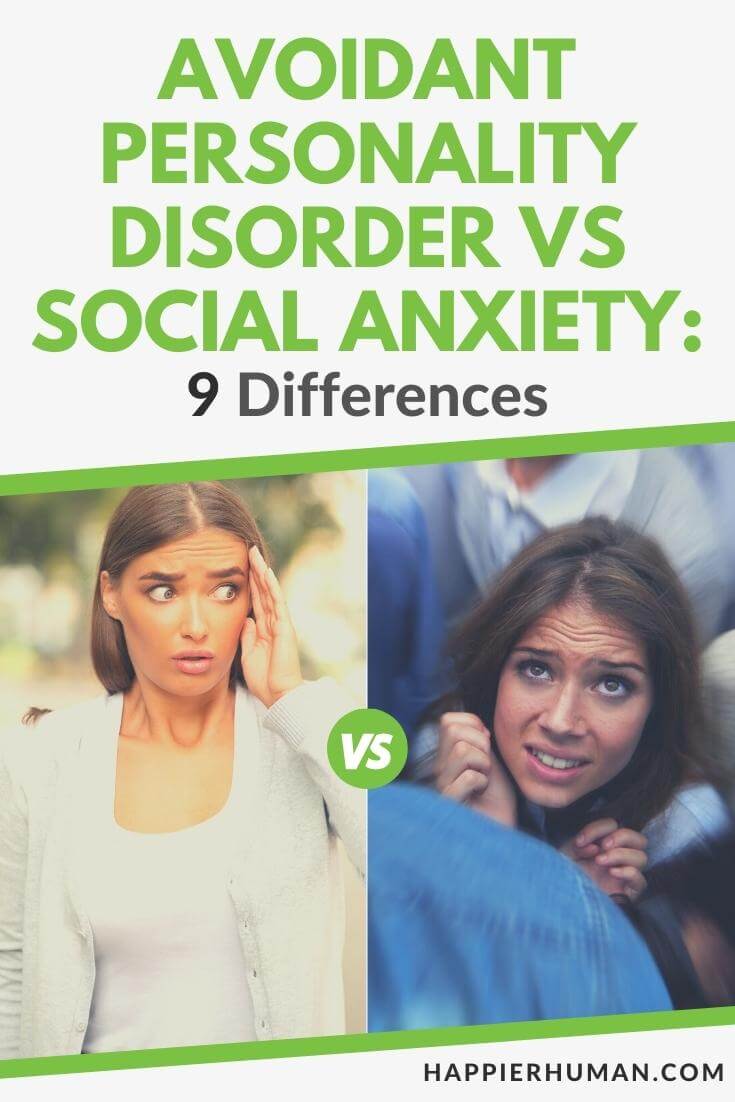There might be affiliate links on this page, which means we get a small commission of anything you buy. As an Amazon Associate we earn from qualifying purchases. Please do your own research before making any online purchase.
Avoidant personality disorder (AVPD) and social anxiety disorder (SAD) are two mental health conditions that can interfere with daily functioning and your overall quality of life. AVPD and SAD can be easily confused as one and the same because they share some common features. Clinically, they are separate disorders with distinctive root causes.
Identifying the differences between avoidant personality disorder vs social anxiety should provide more clarity on which one you're experiencing. For psychologists, differentiating between the two is crucial for diagnosing patients and tailoring the right treatment plan.
Today, you'll learn the characteristics of AVPD and SAD, nine notable differences between the two, and when to seek professional help.
What Is Avoidant Personality Disorder?
Avoidant personality disorder is one of the cluster C personality disorders and is characterized as having chronic or lifelong feelings of inadequacy and being highly sensitive to criticism, judgment, or rejection. People with AVPD tend to avoid social situations and interacting with others, particularly strangers, due to fear of being embarrassed or judged. On the surface, the individual can appear to be an introvert, but this disorder is more than just being shy and reserved by nature.
According to a study published by Psychology Research and Behavior Management, the following factors can cause someone to develop the disorder:
Common characteristics of avoidant personality disorder
Avoidant personality disorder is a mental health disorder that affects 1.5%–2.5% of the adult population in the US, according to a study. Psychologists identify the condition by looking for primary characteristics or common signs including these:
You may also experience low self-worth all or most of the time or have trouble forming healthy friendships and romantic relationships.
What Is Social Anxiety Disorder?
Social anxiety disorder, or social phobia, is a type of anxiety disorder and a common mental health condition.
According to the National Institute of Mental Health (NIMH), SAD is identified as a persistent fear of social situations where the person feels exposed to unfamiliar people or that their performance may be scrutinized by others.
The individual also fears they may act in a way that causes them to feel embarrassed or humiliated by the reaction of others.
Based on statistics, SAD is more common than avoidant personality disorder and affects an estimated 12.1% of U.S. adults.
Several factors have been identified as the possible root causes of SAD, including:
Common characteristics of social anxiety disorder
Social situations can be uncomfortable for many people, but for someone living with social anxiety, it can be extremely difficult to go out and mingle.

That's because the condition is driven by a high level of fear surrounding social situations. Other hallmark behavioral traits or signs of someone with SAD include:
Individuals may experience low self-esteem because of social anxiety and become hypersensitive to criticism. This in turn may lead to poor social skills or prevent them from asserting their needs and setting healthy boundaries. Magnifying the situation, also called catastrophic thinking, negative self-talk, and ruminating over mistakes made during conversations are other features of social anxiety.
Can Someone Have Social Anxiety and Avoidant Personality Disorders?
Yes. Avoidant personality disorder and social anxiety disorder are diagnosed, separately, using criteria listed in the American Psychiatric Association’s Diagnostic and Statistical Manual of Mental Health Disorders, DSM-5. A person may be diagnosed as having both mental conditions, according to Psych Central. Co-occurrence rates range from 21%-89%. What is crucial to note is that these conditions go beyond normal shyness or initial anxiety and fear in a crowd or public place.
Those experiencing the signs and symptoms may feel highly distressed or severely fearful or anxious. The intensity of these symptoms has the potential to affect their personal and professional life since it interferes with their ability to communicate or form relationships. SAD and AVPD may lead to social isolation and alcohol or drug abuse to cope with negative emotions or perceptions and loneliness caused by self-isolation.
Avoidant Personality Disorder vs Social Anxiety: 9 Differences
Avoidant personality disorder and social anxiety have two core key features, which are fear of embarrassment in social situations and being judged by others. They also share similarities like social awkwardness. To make things simple, I've emphasized the ways in which having an avoidant personality differs from social anxiety by highlighting the root causes and traits of AVPD that aren't prominent in those with SAD.
1. APVD is a personality disorder, but not SAD
Your personality is the sum total of your unique traits, including your attitudes, behaviors, thoughts, perceptions, and how you interact with others. A personality disorder is a mental health condition. There are 10 types and AVPD is identified as one in the DSM-5.
A personality disorder manifests as ongoing, disruptive patterns of thinking, behavior, and mood which affect the way you relate to others. SAD is a chronic fear or phobia about being in social situations where you could be judged negatively or face embarrassment.
2. Avoidant personalities avoid social situations due to high sensitivity to criticism
People with AVPD avoid social situations out of deep-seated fear of judgment, criticism, and ridicule, while those with SAD avoid socializing due to fear of social engagement. People with anxiety generally experience fear, dread, worry, uneasiness, and apprehension about what's to come.
These feelings trigger symptoms such as panic, sweating, and rapid heartbeat. Notably, the anxiety felt by those with social phobia is linked to possible embarrassment. It also relates to being seen in a negative light, e.g., during an interview or while eating in the presence of others.
3. Intense fear of rejection is a key factor in AVPD
According to the Cleveland Clinic, people with AVPD are “highly sensitive to being negatively judged by others.” They desire interaction with others, but also have an intense or debilitating fear of rejection that can cause them to avoid social connections.
Instead of an intense fear of being rejected, those with SAD feel easily embarrassed, particularly if they believe their appearance or performance isn't up to the perceived standards of others.
Furthermore, they don't feel this way in non-social settings or among familiar people. In contrast, avoidant personalities are continuously in fear of judgment even around their partners, family members, and friends.
4. Individuals with AVPD feel chronically inferior
AVPD is driven by strong feelings of inferiority and the individual's assumption that others think the same about them. Already feeling less than others or unworthy makes those with the condition highly sensitive to criticism, as it sort of reinforces this negative self-perception.

They are also just as fearful of rejection and will stay away from people or situations that they think will expose them to such experiences.
I did not come across any literature that points to an inferiority complex as being an underlying cause of SAD. While people with social phobia have their insecurities, they may not experience them in a debilitating way as seen in AVPD.
Even though they are self-conscious and somewhat insecure, it's not to the point of feeling completely socially incompetent, inadequate, or inferior.
5. Avoidance personality is rooted in negative self-perception
Poor self-image and low self-esteem play a crucial role in AVPD. In fact, the disorder is rooted in negative self-evaluation. Those who have the condition are highly critical of themselves, mainly due to poor self-image. It doesn't stop there.
They project their negative self-perceptions onto others and assume others see them the way they see themselves.
Those with SAD, like others, experience low self-esteem and a lack of self-assurance. However, those feelings aren't rooted in negative self-image and can be short-lived. Their feelings are more related to performance anxiety, e.g., if their ideas or work will be negatively scrutinized.
6. APVD individuals lack insight into their sensitivity to judgment
Levana Slabodnick, LISW-S, a therapist in Columbus, Ohio, explained that “A fundamental difference between social anxiety disorder and avoidant personality disorder relates to how the sufferer perceives their own pain.” Slabodnick further explained that those with AVPD lack the insight that their extreme fear of criticism and judgment is irrational.
On the contrary, those with anxiety have a basic understanding that their fear of social situations is irrational, and that the world doesn't judge them as they perceive it.
Moreover, researchers found that people with an avoidant personality disorder have lower self-awareness than those with SAD. That helps explain why they often don’t see how avoidance isn't a solution, but rather problematic.
They cannot see how their distorted thoughts and behaviors about themselves and others negatively affect their lives.
7. AVPD involves a greater scope of avoidance
Avoidant personality typically involves a persistent pattern of avoidance. The person tends to display a high level of avoidance in all areas of life. Choosing avoidance as a solution backfires and affects all areas of their life. On the other hand, social phobia usually only involves avoidance in a few specific situations, e.g., public speaking or meeting new people.
According to psychological experts, people with both conditions desire to connect and interact with others, but those with AVPD are less willing to make an effort. They are also more likely to avoid all social interactions.
Resistance to socializing puts them at a greater risk of self-isolation and having fewer close relationships.
8. People with AVPD have a pervasive and long-term desire to avoid
Avoidant personalities have to deal with their negative self-image and negative emotions all of the time. That's because it's a disorder or personality flaw that doesn't go away, although treatment can be beneficial.
Therapy can bring about increased self-awareness and provide tools to manage avoidance triggers.
In the case of SAD, the fear and anxiety symptoms usually subside once the individual is no longer exposed to the perceived threats of scrutiny or judgment. They are usually relieved when around familiar or trusted people, such as family and friends.
9. AVPD is linked to a higher risk of depression
AVPD symptoms indicate a more severe personality dysfunction and a higher risk of interpersonal problems, according to a study.
The same research concluded that the disorder is strongly associated with eating disorders and panic disorders. Another study found it often co-occurs with chronic depression.

The tendency to socially isolate themselves due to feelings of unworthiness or avoiding criticism is an unhealthy coping mechanism. Isolation has a confirmed connection to loneliness, generalized anxiety, depression, substance abuse, and suicidal thoughts.
When to Seek Help
Moderate to severe AVPD and SAD can affect your day-to-day life in a significant way. Consider reaching out to your doctor or a therapist if you notice any or all of the following problems:
Treatment Options for Avoidant Personality Disorder vs Social Anxiety
Treatment will depend on the diagnosis.
NB: Both conditions can be treated simultaneously in therapy if they co-occur.
Alternative coping strategies include:
Final Thoughts on Avoidant Personality Disorder vs Social Anxiety
Anyone can suffer from these two mental health conditions… nobody is immune. What matters most is recognizing how they affect your life and taking the necessary steps to manage and eventually overcome their effects.
Therapy and self-help strategies can provide the awareness necessary to engage socially with a positive attitude. Always start with the latter, mindfulness and mental health apps are great for daily self-esteem boosts.
Still, you should never be ashamed to seek professional help if they aren’t enough on their own. Think you may be struggling with SAD? Discover 6 Authentic Ways to Deal with Social Anxiety in ANY Situation.
Finally, if you want to identify YOUR personality type, then take one of these 11 personality tests to better understand what makes you tick.


